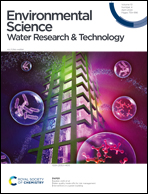Cephalexin interaction with biosolids-derived dissolved organic matter: binding mechanism and implications for adsorption by biochar and clay†
Abstract
Trace levels of the β-lactam antibiotic cephalexin are known to persist through wastewater treatment processes, possibly promoting antibiotic resistance in environments that receive treated wastewater. Processes that impact antibiotic treatment in wastewater, such as binding to dissolved organic matter (DOM), may regulate the environmental fate of antibiotics, yet cephalexin–DOM binding has not been probed previously. Here we studied cephalexin binding onto biosolids-derived DOM using fluorescence quenching and studied the impact of DOM on cephalexin adsorption onto clay and biochar under conditions where cephalexin–DOM binding occurs. Interaction was studied under varying solution pH (4.0 to 8.0), ionic strength (deionized water and I = 0.1 M) and background cations (Na+ and Ca2+) to determine binding mechanism(s). We observed no binding at pH = 8.0, while cephalexin binding to protein-like fluorophores in DOM was increasingly strong with decreasing pH from 7 to 4. Conditional equilibrium constants varied considerably with pH, with log Kc = 8.48, 7.15 and 5.33 for pH = 4.0, 5.0 and 7.0, respectively. Cephalexin–DOM interaction was insensitive to changes in solution ionic strength and cation charge. These results suggest π–π bonding likely drives cephalexin–DOM binding, with the aromatic group of cephalexin interacting with substituted aromatic groups on DOM. Lastly, we showed reduced adsorption of cephalexin from synthetic wastewater onto biochar and clay by DOM under conditions where cephalexin–DOM interaction occurs. This work demonstrates that cephalexin–DOM interaction likely occurs in aquatic environments, with interaction most strongly controlled by pH. We also show that this binding may influence adsorptive treatment and fate in wastewater streams and, therefore, cephalexin fate in the environment.



 Please wait while we load your content...
Please wait while we load your content...